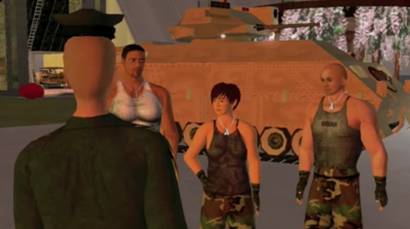Cooperation over borders between individuals and groups is possible using online three-dimensional virtual worlds. 1 This cooperation occurs in the production of art, research, teaching and learning, and performance as well as in building social, professional and personal contexts. The borders that are crossed can be geopolitical, generational, spatial and embodied. In order to maintain coherence for people to meet, talk, build, write, perform and exchange in virtual worlds, a sense and understanding of place is required. Such human activities as meeting are reliant on a shared space and place. This chapter integrates the idea of sharing places in examples of how virtual worlds can provide common spaces and places from a series of projects involving art, documentation, teaching and communication. By using examples of one artist’s project and several machinima – videos made using screen-capture software on computers, to film places and avatar actors in virtual worlds – I argue these virtual worlds can enable cooperation over a variety of borders through sharing.
Virtual Worlds
Virtual worlds are multimedia, digital, three-dimension environments that are accessed simultaneously by multiple users represented as avatars - three-dimensional bodies in the world - that render in real-time and are synchronous, persistent and facilitated by networked computers. In virtual worlds
"Participants communicate and interact with each other and the environment. It is an ecosystem in which the actions of a participant ripple through the world affecting every other part of the system. "2
Synchronous communication operates in real-time as a shared activity. Reliant on this activity is ‘the notion of a ’common time’ [that] allows for mass group activities and other coordinated social activities.’ 3 Associated with synchronous communication, virtual worlds are also persistent, as when one logs out or leaves a location within the world, the world continues on regardless. A virtual world cannot be paused. Any action taken by an avatar in a virtual world becomes part of that world. Along with this holistic understanding, we can add that virtual worlds are places that perform a number of functions in common with those places our bodies interact with every day. The most obvious is they provide a location and a temporality. In doing so these technologies make it possible to transverse the geopolitical boundaries that nation states are based on.
Virtual Worlds as Places
If we are to define virtual worlds as distinct places in terms of populations, the virtual world of World of Warcraft (WoW) has 10.2 million subscribers (Holisky), in Second Life (SL) approximately 800 000 logins are performed every month (Linden), and the teen-fashion world ‘Stardoll is the most popular, with 69 million registered users.’ 4 In terms of economy, virtual worlds such as Second Life and Planet Calypso include the possibility to earn and spend money, own property, charge rent and operate a business. Economy, investment and some form of membership are all indicators of place-based presence in virtual worlds. What people who inhabit virtual worlds are part of is the metaverse, first coined by Neal Stephenson in his 1992 science fiction novel Snow Crash, which is defined as ‘a shared virtual social space with 3D capacity, but which in many instances does not represent to the user as 3D.’ 5 Coincidentally the perception of three-dimensionality is not essential for the perception of place either. A place can be solely linguistically mediated, such as the Dublin of James Joyce’s Ulysses, which later results in the numerous tours and monuments that have emerged from it in ‘real’ space. However, virtual worlds are mostly three-dimensional representations and within this spatial structure there is the linguistic mediation of place.
Place is a complex and multidimensional concept, but central to any place is the ability to name it. A location without name is not a place; it is a site with coordinates and attributes. In going back to the earliest conceptions of place in our culture, Edward S. Casey explains, ‘narrative accounts of creation must bear on place as they rely on time and language.’ 6 Many creation narratives rely on the creation of place. In Christian mythology creation is with the Word, ‘In the beginning was the Word, and the Word was with God, and the Word was God.’ 7 The first man, Adam was given the task of naming the beasts, the fish and the foul, but God named the places: the sea and the sky, and the land. 8 The naming was thus intrinsic in the creation and it was only when they were named that they became habitable. All things had their place in the ordered cosmos of the creator God. What the creation story shows is the interdependence of language and place according to organizing principles. The same principle is applied to virtual worlds as an organizing principle. The two largest land-based worlds; The Elder Scrolls II Daggerfall measuring in at 39.9 million acres and The Lord of the Rings Online at 19.2 million acres are organized for inhabitants according to places in maps. Places are named, these names become part of the coding of the virtual worlds, permitting teleports and movement to particular locations such as the ‘HUMlab Region’ in Second Life.
Inhabitants Make Virtual World Places
Who shares places in virtual worlds can be determined according to the demographics of those that inhabit them. Based on research done by Lewis, Jr. and Ford-Robertson (2012) the five major demographic groups present in the United States today are;
- The Traditionalists are the oldest individuals in American society. They were born between 1922 and 1945. Traditionalists are known as loyalists, veterans, and the Greatest Generation, having won World War II and endured the Great Depression.
- Baby Boomers are the children of Traditionalists and they are the second oldest grouping of individuals in the United States. They were born between 1946 and 1964. Boomers have been described as optimistic and driven at work and play. The Vietnam War, the Civil Rights Movement, and space travel frame their historical reality. There are 77 million Baby Boomers.
- Generation X is one of the younger age cohorts and it is comprised of the children of Baby Boomers. Individuals in this grouping were born between 1965 and 1979. They are known as the baby busters and were characterized as ‘latch-key’ kids. The fall of the Berlin Wall, the explosion of the Space Challenger, and MTV are elements that frame this group’s historical focus. There are 49 million Generation Xers.
- The Millennial cohort is the youngest age group in the workplace. They are the children of Baby Boomers and Generation Xers. Individuals in this group were born between 1980 and 2000. An around-the-clock world, the World Trade Center attacks, homegrown terrorism, cell phones, and the expansion of the Internet are historical events that frame this group’s reference. There are about 74 million Millennials.
- The iGeneration or Generation Y are the children of Millennials and Generation Xers and were born after 2000. Their focus is inward and it is being fashioned by iPods, iPads, and other technologies. There are 44 million in the iGeneration and it will continue to expand. 9
The Demographics of age in virtual worlds show a spread that reflects society in its segmentation if not in its ratios. The age spread in Second Life is more uneven in how it reflects the actual population. In Second Life, which is a social and not a gaming world, 75% of the population is taken from the demographic that represents just 39% of the actual population of the USA:
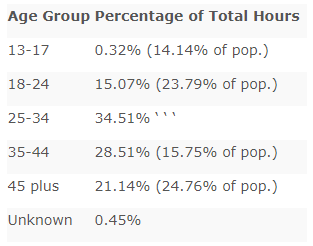
As a comparative example from another virtual world, a study by PARC from 2005 of demographics in World of Warcraft provides a clear break down across three major geo-political configurations of the USA, China and Europe and focuses on ‘single’, ‘no children’ and ‘full time student’ as attributes. 11
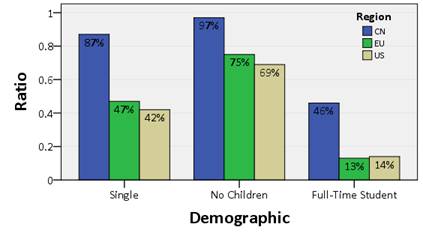
According to the PARC study, World of Warcaft 87% of the CN participants are single, whereas this was true of a near even split of 47% in the EU participants and 42% for the US participants. A long above median of 97% for CN participants do not have children, compared with 75% of EU participants and 69% of US participants. Without age demographics it is difficult to attribute so much to the parental attribute. And finally, an even 46% of CN participants are full-time students, compared with 13% and 14% of EU and US participants respectively. While these figures obviously do not reflect the demographics in the participant’s nation states, the mix of ages, marital situations and dependencies in virtual worlds provides identity to the spaces of World of Warcraft as composed of places. In doing so such virtual worlds have the potential to result in cooperation over demographic borders. This cooperation is based on the mixing of ages, nationalities and ethnicities, social contexts and occupations. The results of this cooperation are ‘typical patterns of WoW play appear to enhance real life relationships, not replace them, and sizable percentages of players across all regions made new real-life friends in the virtual world’ (Schiano et al 5). While not present here in evidence, it is fully possible that this cooperation extends over social strata, genders and languages based on the demographics cited above.
Place and the Embodiment of Space
The spaces of virtual worlds, and the machinima that is made in them, are centered on a conception of the body as defined place. As part of the place-ness of the body it is important to understand that ‘‘space’ [is] more abstract than ‘place’. What begins as undifferentiated space becomes place as we get to know it better and endow it with value.’ 12 Becoming familiar with space and endowing it with value is dependent upon inhabitation over time, and a presence that comes from the perspective of embodiment. Presence is the ‘sense of being there’, or the ‘feeling of being in a world that exists outside of the self.’ 13 As Edward S. Casey states, ‘poets and topoanalysts both recognize the privileged status of the body in getting us back into place.’ 14 Place requires embodiment, in order to be ‘somewhere’ there must be a point the physical entity can be situated, even if it is only in terms of perspective. In virtual worlds embodiment is achieved with the avatar. The avatar is an embodied agent, usually represented as a humanoid figure, which interacts with the surroundings and other avatars in the virtual world. The avatar in many online worlds creates a third-person perspective, whereby the personality controlling the avatar watches the avatar. Often the perspective is first-person, where the personality controlling the avatar sees through its eyes and moves in its own limited visual field. In the first-person perspective the only visual referent for the body in the virtual world is often one or two hands or arms, or beings able to manipulate tools and weapons with limbs and hands. Both first and second person systems create a sense of embodied presence in relation to the virtual world. I would now like to turn to a number of projects that work with the sense of place, space and embodiment as I have described them and result in the transversal of borders using virtual worlds and their images.
The Projects
Yoshikaze Up-in-the-Air Residency
The Yoshikaze Up-in-the-Air Residency is an artist in residence program that has been run since 2010 from within Second Life (SL) by HUMlab, a digital humanities lab at Umeå University in Sweden. Yoshikaze is curated by Japanese/Swedish artist Sachiko Hayashi and managed by the present author. Contact between students, staff from Umeå University and HUMlab and the world outside has been taking place in the virtual spaces of SL for a number of years. This contact occurs on the two sims (islands) HUMlab runs, as well as in the SL studio of Yoshikaze. Each Yoshikaze residency ends with an exhibition in the physical space of HUMlab, accompanied by a talk or performance by the artist. The Yoshikaze exhibitions so far have both shown the work from the residency and included the artists performing or speaking to people from across the campus and disciplines. The residency has resulted in exciting meetings in a spatially extended HUMlab. To end each residency HUMlab provides a gallery-style show in a 250 sq meter space with eleven 54’ plasma screens in a surround arrangement with sound and lighting and a 4000-pixel monitor screen. The final exhibition runs for a week following the opening event and is maintained by the HUMlab staff from 8am to 5pm, Monday to Friday. The artist presentations are live streamed in the exhibition on the large monitor screen. The Yoshikaze concept goes beyond the land/space of the site in SL, and it becomes an event integrated into the physical life of HUMlab. When you are doing a Yoshikaze residency, you are working in HUMlab. The intention is for the borders between the two spaces to be transparent.
A series of artist’s talks and performances within the Yoshikaze project have attracted considerable local interest on the campus of Umeå University. However the greatest amount of interest has been international and virtual. In one final exhibition, unknown at the time to the organizers, the work from a residency was presented at Media in Transition 7, at MIT on May 15, 2011. In this way the audience is often dispersed temporally and spatially, multidimensional, and sometimes invisible. The SL space itself is open also, and anyone can log in and go and speak to the artist in the Yoshikaze studio or Instant Message them. These artists nearly always appear and work as their avatars. It is not even necessary to know their real names. They are accepted as their avatars and sometimes never reveal the details of their lives behind the screen. When it comes to the space of Yoshikaze in SL the idea of the audience disappears somewhat and the onus rests upon participation by all in the space as an inhabitant.
The Yoshikaze residency by Selavy Oh and the work CONSTRUCT from 2011 are examples of the interaction of people, objects and the spaces of SL. Inside SL CONSTRUCT metamorphasizes around the viewer and pulls in images and symbols from the online identity of each visitor. One blog review states that CONSTRUCT is ‘a thinking machine, a machine that thinks, which one can watch as it ponders images, observes its own perceptions, making and unmaking connections unceasingly’ (Dividni Shostakovich). Films were made of these processes over the 75 days of the residency and some were shown at the final exhibition. 15 The printed codes running the processes, a new one for each of the 75 days, were also shown in the exhibition. The documentation is often what is shown in the final exhibition, but the ‘work itself’ is often what is created inworld. The gallery situation sets up an audience, but the work has in some ways already happened. It is then that the artist may stage a performance and an audience is of course required for that portion of the residency. The creativity of Yoshikaze operates on so many layers, in augmented or fractured spaces and across time. The audience just has to find a spot in one of them and observe, participate or read what is going on around them.
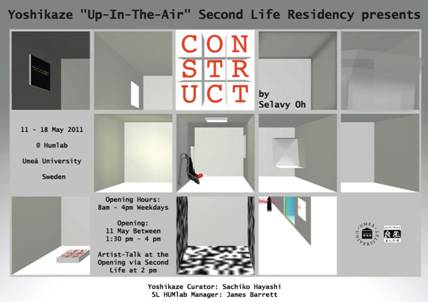
Machinima Film
Virtual worlds can be considered places and machinima is evidence of this. Machinima is a technique for making moving images or films from three-dimensional virtual spaces (games, social worlds, interactive 3D) using screen-capture programs. Due to the nature of the production process machinima requires the creation of virtual space prior to the recording process. In machinima the virtual world, its inhabitants and all their actions in it are captured ‘on film’. Any act of creation that occurs in the places of virtual worlds, such as the making of machinima film, takes on the elements of where it ‘takes place’. In the case of game worlds, machinima,
“Action occurs within a constant and virtually concrete online world, running temporally parallel to that of the player. The original, creative element of the process occurs when the director decides what to shoot, where, and from what angle, and how to frame it.’ 16 ’
The objects created in pre-production; clothes, furniture, vehicles, buildings, architectures and utensils, along with the history and community of the world itself, lend to the specifics of a place in the location of filming. The film itself becomes the fashioning of an image of that place. Perspective, angle, frame and its contents are all made by the machinimist in the act of filming. As I shall demonstrate in the examples below, place-bound context and even history are provided according to where a machinima film sequence is made in a virtual world. Machinima contributes and derives from the ‘place-ness’ of virtual worlds as a means to dramatize and report upon the events that occur in these places.
The French Democracy
The French Democracy is a machinima film that demonstrates how creating a place in a virtual space can transverse the borders. The French Democracy takes up the electrocution death in 2005 of two teenagers, Zyed Benna and Bouna Traoré, while hiding from the police in a Parisian suburb. In The French Democracy, Alex Chan relies on the creation of a representational virtual space to portray the deaths of Benna and Traoré using the Lionhead Studios’ 2005 game ‘The Movies’. As part of this portrayal Chan makes references to the events leading up to the Paris riots of 2005. Along with the deaths of Benna and Traoré, the perceived economic marginalization, limited opportunity, and discrimination experienced by immigrants in France in portrayed in the machinima. Following the deaths of the two boys and statements made by the French government, riots ensued in the housing projects of Paris. These events form the referential bases for The French Democracy. Chan stated in 2005 upon the films release,
“[The French Democracy is] a shortcut made with The Movies technology about the recent events concerning riots in French suburbs. This movie is trying to help people have a better understanding of the origin of these events, as some reasons that pushed all this youth to have such violent acts. As a matter of fact TFD offers a sincere inside view from a French citizen who lives in one of these neighborhoods where the riots took place. This fictional documentary is strongly inspired by real events and reactions and tries to make the spectator think more about how French society could and should potentially be. 17 ’
The relative material ease with which machinima can be made and the possibility to distribute it quickly and massively over the Internet crosses borders. The French Democracy represents social class and the geo-political from ‘the other side’ of how events were represented in much of Europe at the time. The French Democracy transcends the image of apolitical hooligans assigned to the rioters in a simple and effective manner. The resulting rhetorical power held by The French Democracy gives us some idea of how machinima can cross borders in reception.
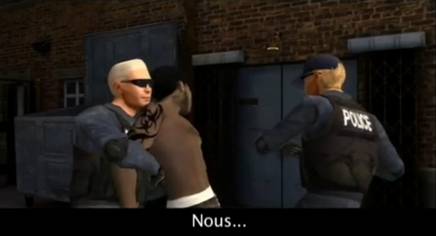
Machinima Interview
The compendium volume Understanding Machinima: Essays on Filmmaking in Virtual Environments (Continuum Books, Forthcoming) is an example of border transversal based on virtual worlds and machinima. The project includes the work of Isabelle Arvers, a French machinamist from Meyrargues in Bouches-du-Rhône department in southern France, who is a media art curator, critic and author, specializing in video and computer games, web animation and digital cinema. She has coordinated ISEA 2000, Paris, and she has curated Video Cuts 2001, Centre Pompidou, Gaming Room Villette Numérique 2002, Paris, Tour of the Web 2003, Centre Pompidou, featuring French and international artists. Isabelle works with machinima as a medium for education, art and play. Isabelle understands machinima as a folk art, a kind of ‘digital hip hop’ where the young and the marginal can express themselves and what is important to them. I have never met Isabelle, but we have met in Second Life, conducted interviews and discussions there and planning of future projects.
One example of how this works is an interview that was conducted for the multimedia component of the book Understanding Machinima. The books is to be published with QR – Quick Response – Codes in the text so readers can access online content directly in their mobile devices in an attempt to coordinate the eye and the hand, the page and the screen. For the digital content of the book, an interview was filmed from HUMlab in the north of Sweden, the interviewer Jenna Ng was in the United Kingdom at Cambridge University and Isabelle was in Provence, in the south of France. In this way we formed a triangle over Western Europe in our conversation. The intention was to have a short chat inworld and then meet again shortly to record more conversation, but as we roamed around Second Life looking for a place to film we talked in comfortable dialogue with each other. When we found a grassy slope we stood still and the conversation blossomed and was filmed. It was a matter of the right place at the right time. Borders were crossed in the creation of this machinima interview; the political and temporal borders of the European continent as well as the borders of walls, buildings and distances. 18

Teaching Culture Analysis Using a Virtual World
In the Fall Term of 2009 students from the cultural analysis program at Umeå University in Sweden were introduced to Second Life as part of their course work in HUMlab. The students were instructed in the basics of being in the virtual world. They were expected to learn the program by using it and to socialize in the space of Second Life, documenting with video capture software, and editing it. Instead the students used the virtual world as a space for collaboration; where they built sets, developed characters and made machinima films. Deutschmann and Moka-Danielsson identify Second Life and worlds like it as simulations, where ‘the key element here is, according to Svensson, not the technology, the simulations or the effects per se, but the fact that SL and worlds like it allow for meetings with ‘real people (‘playing’ themselves or having alternate personas), for working collaboratively with remote participants’ and for the creation of a ‘place and a unified spatial interface’ for such meetings.’ 19 With a place and a unified spatial field the results were three machinima films; I huvudet på en Student (In the Head of a Student), Gud och Hela Nation (God and Country), and Another Love Story (2009), which capture meetings between people as avatars in places within the virtual world. 20 These films are the documentation or the enactment of creative, scripted scenarios.
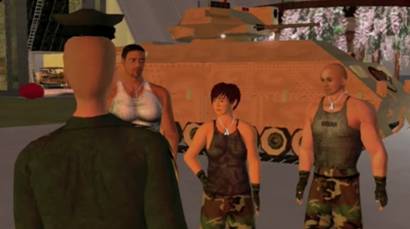
Finally, embodiment is utilized in machinima by the careful manipulation of active bodies, not images of bodies, as avatars. Avatars in virtual worlds are the vehicles of their personalities or the people who design, build and control them. They are capable of expressing themselves in ranges that mimic an actual human body in many ways. The manipulation of hair, physical build, textures, proportion and all the trappings of fashion are some of the signifying systems presented in avatars. In the documentation of this, the physical embodiment offered by virtual worlds lends itself to machinima film. The focus, frame, perspective and depth of the filmic image are replicated in the screen capture technology and the spatial configuration of machinima. Avatars are the subjects of machinima. Furthermore, the embodiment offered by virtual worlds obeys the rules of the physics encoded into the programs. Dropping things, falling, flying, running, building and so on are attributed to the physics engines. These factors combine to result in a perspective of the avatar body, where accidents happen, where shadows fool the eye and strangers meet to exchange email addresses without knowing what will happen next. The students of the culture analysis course captured elements of the randomness of virtual worlds in their machinima works. Individual moments are incorporated into the machinima films in an effort to represent the time and space of the places inhabited, which are always changing ‘in real life’.
Conclusion
The possibilities for cooperation over borders using virtual worlds are indicated by the few examples dealt with in this short account. From these examples Age, Geography, Nationality and Nation are demonstrated to be somewhat transversed in the places created with virtual worlds. Furthermore, in the places offered by virtual worlds it is possible to communicate, create and learn. For those not in virtual worlds, machinima film provides a ‘window in’ to what happens within their structures, by reporting back in the documenting of events and the telling of stories. The results are valuable cultural artifacts that can teach us about the nature of present day society and its media. With new virtual worlds emerging all the time, many of which are based on collaborative activities (e.g. Minecraft), the need is there to explore virtual worlds and create knowledge based on this media phenomenon.
Print Cited
Alexandria, Michelle, ‘Making filmmaking a game’ United Press International. 21 December 2005 (Accessed 21 April 2012)
Bell, Mark W., ‘Towards a Definition of Virtual Worlds’ in Virtual Worlds Research: Past Present & Future Journal of Virtual Worlds Vol. 1. No. 1., July 2008, p. 1-5
Borst, Todd, ‘Know Your Customers: Second Life Demographics’ in Virtual World Business, 30 April 2009 (Accessed 12 June 2012
Casey, Edward S., The Fate of Place: A philosophical history University of California Press, Berkley, 1997
Deutschmann, Mats, Molka-Danielsen, Judith, ‘Future Directions for Learning in Virtual Worlds’ in Learning and Teaching in the Virtual World of Second Life. Judith Molka-Danielsen and Mats Deutschmann (Eds.), Tapir Academic Press, Trondheim, 2009, p. 185-189
Eberstadt, Nicholas, ‘The Demographic Future: What Population Growth -- and Decline -- Means for the Global Economy’ Foreign Affairs, November/December 2010 (Accessed 2 May 2012)
Holisky, Adam, ‘World of Warcraft subscriber numbers dip 100,000 to 10.2 million’ in WOW Insider, February 9th 2012, (Accessed May 2nd 2012)
The Holy Bible: New International Version, Zondervan, Grand Rapids, 1984
Lewis, Jr., Dr. Richard, Ford-Robertson, Joanne, ‘Aging in Place: Generational Challenges in the Contemporary Workplace’ 20 March 2012. Profiles in Diversity Journal (Accessed 3 May 2012)
Linden, BK. Q1 2011 Linden Dollar Economy Metrics Up, Users and Usage Unchanged, June 5th 2011 (Accessed 2nd 2012)
Ng, Jenna (Ed), Understanding Machinima: Essays on Filmmaking in Virtual Environments New York: Continuum Books, Forthcoming 2013
PARC, Collecting Data from World of Warcraft, 17 May 2005 (Accessed May 1 2012)
Pasternack, Alex, ‘Virtual World Population Explosion: 1 Billion Users’ in Mother Board. October 4th 2010 (Accessed May 2 2012)
Piggot, Michael, ‘How Do You Solve A Problem Like Machinima’, in The Machinima Reader, Henry Lowood and Michael Nitsche (Eds), The MIT Press, Cambridge, 2005, p. 188-189
Schiano, Diane J., Nardi, Bonnie, Debeauvais, T., Ducheneaut, Nicolas, Yee, Nicholas, A New Look at World of Warcarft’s Social Landscape. 6th International Conference on the Foundations of Digital Games (FDG 2011) PARC (Accessed 12 June 2012)
Smart, J.M., Cascio, J., Paffendorf, J., Metaverse Roadmap Overview . Accelerated Studies Foundation 2007 (Accessed 3 May 2012)
Simmonds, Maureen J., Visual Field Immersion: The Holodeck Comes Alive, McGill University Montreal, PowerPoint Presentation (Accessed 4 May 2012)
Shostakovich, Dividni, ‘CONSTRUCT by Selevy Oh’. Division Street / Divided Path: Encounters with Art, Artists and Arguments in Second Life® (Accessed 2 May 2012)
Tuan, Yi-Fu, Space and Place: The Perspective of Experience, 1977, University of Minnesota Press, Minneapolis, 2001
Yee, Nick, ‘More Demographic Details’ in Play On: Exploring the Social Dimensions of Virtual Worlds, 1 February 2012 (Accessed 3 May 2012)
Games and Virtual Worlds Cited
World of Warcraft. Version 4.3.4 12, April 2012. Blizzard Entertainment (Accessed 25May 2012)
Stardoll. Version 1.0.1, November 2011. Stardoll AB (Accessed 4 June 2012)
Second Life. Version 3.3.2.258114, April 2012. Linden Labs (Accessed June 11 2012)
The Elder Scrolls II Daggerfall. Version 1.07.213, August 1996. Bethesda Softworks (Accessed May 12 2012)
Mindcraft Version 1.2.5. April 2012, Mojang AB (Accessed June 11 2012)
The Lord of the Rings Online Version 5.18, April 2012. Turbine Inc. Midway Games (Accessed May 4 1012)
Call of Duty Modern Warfare 3. Version 1.11, November 2011. Activision (Accessed June 11 2012)
Machinima Cited
Almeflo, Matilda, Ida Moström, Hanna Sundberg, Another Love Story, HUMlab, Umeå, 2009
Barrett, James, ‘A Meeting Between Isabelle Arvers and Jenna Ng’ in Jenna Ng (ed.) Understanding Machinima: Essays on Filmmaking in Virtual Environments, Continuum Books, New York, Forthcoming 2013
Chan, Alex, The French Democracy . Internet Archive, November 2005, Accessed 12 June 2012
Ernestad, Malin. Robin Isaksson, Anna Olsson, Lena Söderholm, I Huvudet på en Student. HUMlab, Umeå, 2009
Hedqvist, Anette. Karin Netzell, Lukas Sundstrom, Gud och Hela Nation. HUMlab, Umeå, 2009
Art Works Cited
Selavy Oh, CONSTRUCT. HUMlab Island. Second Life, Linden Labs. May 2011
-
An audio-visual companion to this essay can be found on line as part of a presentation given at Stockholm University for the conference ‘Les cultures numériques en mouvement’, presented by l’Institut français de Suède, Folkuniversitetet, l’Université de Stockholm and et la revue électronique Sens Public on 9th May 2012. ↩
-
Bell, Mark W. ‘Towards a Definition of Virtual Worlds’ in Virtual Worlds Research: Past Present & Future Journal of Virtual Worlds Vol. 1. No. 1, July 2008, p. 3. ↩
-
Ibid. ↩
-
Pasternack, Alex, ‘Virtual World Population Explosion: 1 Billion Users’ in Mother Board. October 4th 2010. Accessed 2 May 2012. ↩
-
Smart, J.M., Cascio, J. and Paffendorf, J., Metaverse Roadmap Overview. Accelerated Studies Foundation 2007. Accessed 3 May 2012. ↩
-
Casey, Edward S. The Fate of Place: A philosophical history University of California Press, Berkley, 1997, p. 7. ↩
-
The Holy Bible, John 1:1, New International Version, Zondervan, Grand Rapids, 1984. ↩
-
The Holy Bible, Genesis 2:19, 20, 1:6,7,8 New International Version, Zondervan, Grand Rapids, 1984. ↩
-
Lewis, Jr. Dr. Richard. and Joanne Ford-Robertson. ‘Aging in Place: Generational Challenges in the Contemporary Workplace’ 20 March 2012. Profiles in Diversity Journal. Accessed 3 May 2012. ↩
-
Borst, Todd, ‘Know Your Customers: Second Life Demographics’ in Virtual World Business, 30 April 2009. Accessed 12 June 2012. ↩
-
(February 2012. World of Warcraft. Data Source: Core survey data set of 1,795 participants. 640 from mainland China (CN), 279 from the EU, and 876 from the US). Source: Yee, Nick. ‘More Demographic Details’. Play On: Exploring the Social Dimensions of Virtual Worlds. Accessed 1 February 2012. ↩
-
Tuan, Yi-Fu, Space and Place: The Perspective of Experience, 1977, University of Minnesota Press, Minneapolis, 2001, p. 6 ↩
-
Simmonds, Maureen J., Visual Field Immersion: The Holodeck Comes Alive , McGill University Montreal Candad. PowerPoint Presentation. Accessed 4 May 2012. ↩
-
Casey, Edward S., The Fate of Place: A philosophical history University of California Press, Berkley, 1997, p. 291. ↩
-
Videos and other materials of CONSTRUCT can be accessed on line. ↩
-
Piggot, Michael, ‘How Do You Solve A Problem Like Machinima’, in The Machinima Reader, Henry Lowod and Michael Nitsche (Eds), The MIT Press, Cambridge, 2005, p. 188. ↩
-
Alexandria, Michelle, ‘Making filmmaking a game’ United Press International. 21 December 2005, Accessed 21 April 2012. ↩
-
A small portion of this machinima interview can be viewed on line. ↩
-
Deutschmann, Mats, Molka-Danielsen, Judith, ‘Future Directions for Learning in Virtual Worlds’ in Learning and Teaching in the Virtual World of Second Life. Judith Molka-Danielsen and Mats Deutschmann (Eds.), Tapir Academic Press, Trondheim, 2009, p. 189. ↩
-
All the machinima films by the students can be viewed on line. ↩
